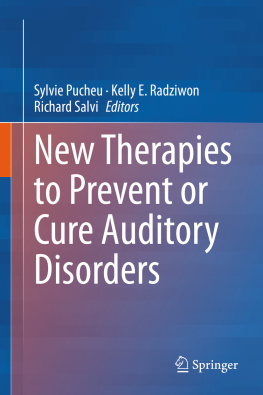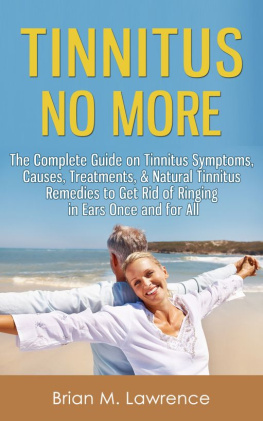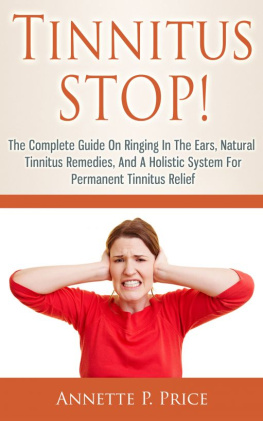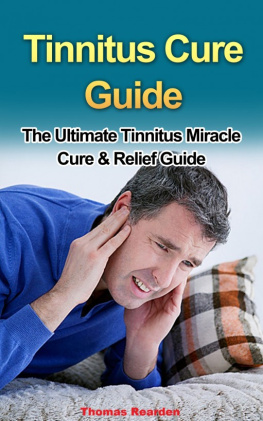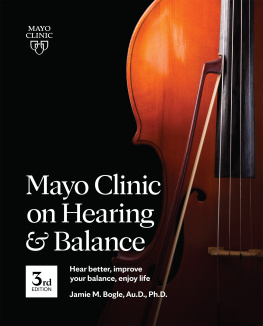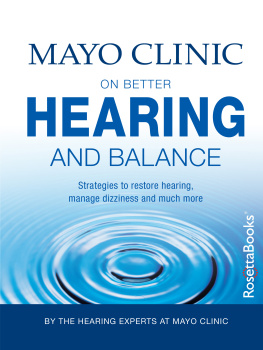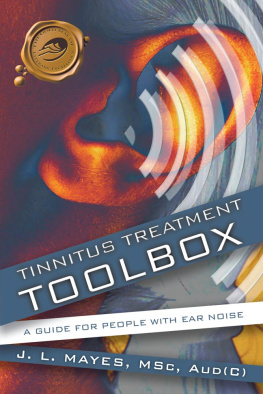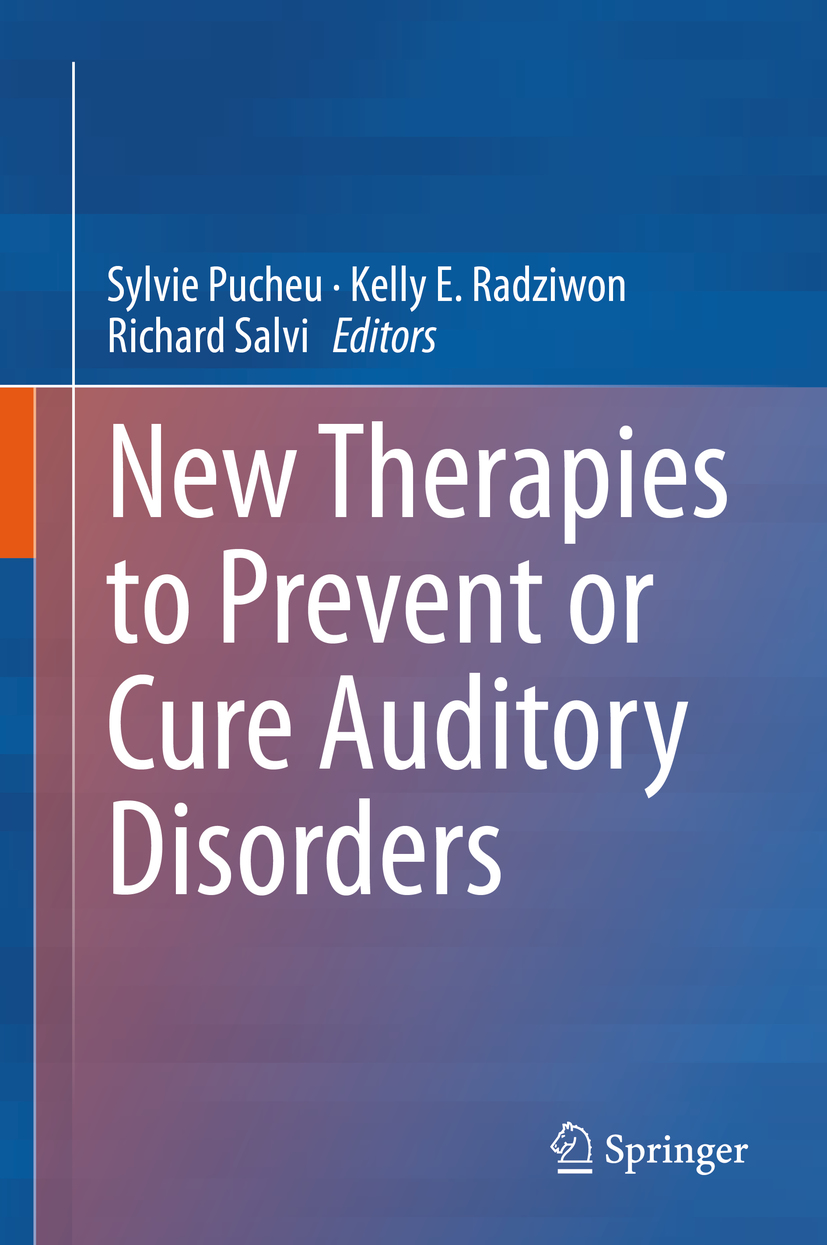Editors
Sylvie Pucheu
CILcare, Advanced Solution for Drug Development in Hearing Disorder, Montpellier, France
Kelly E. Radziwon
Center for Hearing and Deafness, University at Buffalo, Buffalo, NY, USA
Richard Salvi
Center for Hearing and Deafness, University at Buffalo, Buffalo, NY, USA
ISBN 978-3-030-40412-3 e-ISBN 978-3-030-40413-0
https://doi.org/10.1007/978-3-030-40413-0
Springer Nature Switzerland AG 2020
This work is subject to copyright. All rights are reserved by the Publisher, whether the whole or part of the material is concerned, specifically the rights of translation, reprinting, reuse of illustrations, recitation, broadcasting, reproduction on microfilms or in any other physical way, and transmission or information storage and retrieval, electronic adaptation, computer software, or by similar or dissimilar methodology now known or hereafter developed.
The use of general descriptive names, registered names, trademarks, service marks, etc. in this publication does not imply, even in the absence of a specific statement, that such names are exempt from the relevant protective laws and regulations and therefore free for general use.
The publisher, the authors, and the editors are safe to assume that the advice and information in this book are believed to be true and accurate at the date of publication. Neither the publisher nor the authors or the editors give a warranty, expressed or implied, with respect to the material contained herein or for any errors or omissions that may have been made. The publisher remains neutral with regard to jurisdictional claims in published maps and institutional affiliations.
This Springer imprint is published by the registered company Springer Nature Switzerland AG
The registered company address is: Gewerbestrasse 11, 6330 Cham, Switzerland
Introduction
Hearing disorders affect more than 15% of people worldwide. One out of three people over 65 years of age has disabling hearing loss, with 80% of young people at significant risk of hearing impairment. The World Health Organization (WHO) estimates that by 2050, 10% of the worlds population will have disabling hearing loss. Currently, sensorineural hearing loss (SNHL) is the most common type of hearing disorder, accounting for almost 90% of reported hearing loss. SNHL is characterized by the loss of sensory hair cells in the cochlea and/or neural damage in the auditory pathway. Since hair cells cannot regenerate in the human cochlea, SNHL is permanent. Multifactorial etiologies for SNHL include aging, noisy lifestyles and work environments, infections, and more than 300 ototoxic drugs on the market, including the commonly used cancer drug cisplatin. This volume provides an up-to-date resource on the mechanisms underlying hearing disorders, including related pathologies such as tinnitus, a phantom auditory sensation, and hyperacusis, a loudness intolerance disorder, and provides potential strategies for ameliorating auditory dysfunction.
The first chapter by Shinichi Someya et al. provides an overview of the current literature on interventions for age-related hearing loss (AHL), also known as presbycusis, with a particular emphasis on calorie restriction (CR), a lifestyle-based intervention. Chapterby Celia Escabi et al. describes the anatomical, physiological, and perceptual consequences of noise trauma, as well as emerging treatments to alter the biological mechanisms, broadly classified as metabolic (oxidative stress, excitotoxicity, or apoptosis) or mechanical, that normally lead to injury and death of cells in the organ of Corti, spiral ganglion, and/or the lateral wall.
Chapterby Bohua Hu and Celia Zhang describes cochlear inflammatory activities in acute and chronic stress conditions and suggests that controlling the cochlear immune state could offer protection against pathogenesis.
In Chap.) by Amandine Laboulais et al. introduces two robust measures of hearing loss and tinnitus in preclinical models involving a new automatic counting method to quantify hair cell loss and an objective imaging method developed during a collaborative project between CILcare, KeenEye, and Charles Coulomb Laboratory. Ultimately, the goal of each chapter is to provide relevant insight into current models of hearing disorders, including their underlying mechanisms, which will help pharmaceutical and biotechnology companies develop therapies to treat and prevent these hearing impairments.
Richard Salvi
Sylvie Pucheu
Kelly E. Radziwon
Buffalo, NY, USA CILcare, Advanced Solution for Drug Development in Hearing Disorder, Montpellier, France Buffalo, NY, USA
Contents
Shinichi Someya , Christina Rothenberger and Mi-Jung Kim
Celia Escabi , Monica Trevino , Eric Bielefeld and Edward Lobarinas
Chaitanya Mamillapalli , Asmita Dhukhwa , Sandeep Sheth , Debashree Mukherjea , Leonard P. Rybak and Vickram Ramkumar
Muhammad Waqas and Renjie Chai
Bo hua Hu and Celia Zhang
Kelly E. Radziwon , Senthilvelan Manohar , Benjamin Auerbach , Xiaopeng Liu , Guang-Di Chen and Richard Salvi
A. Laboulais , S. Malmstrm , C. Dejean , M. Cardoso , T. Le Meur , L. Almeida , C. Goze-Bac and S. Pucheu

